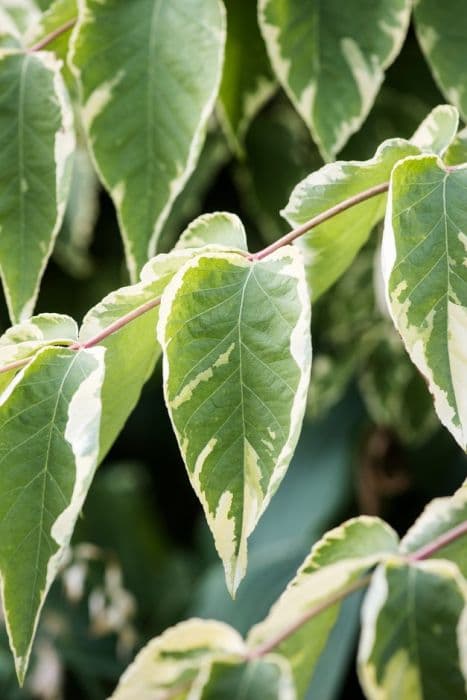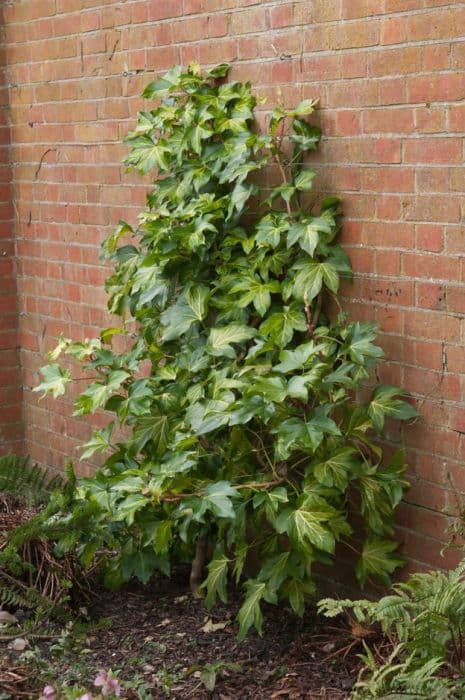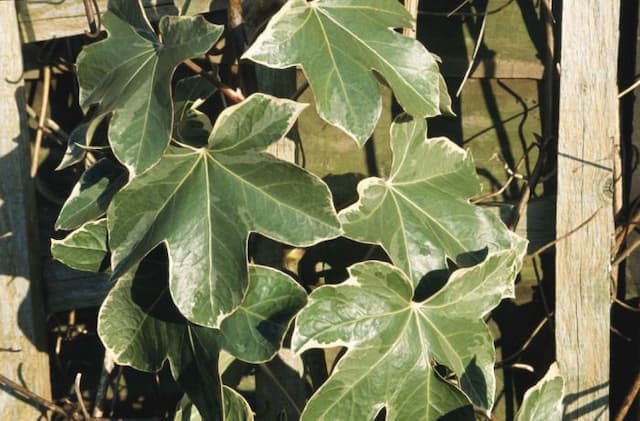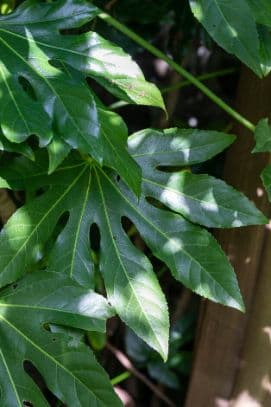English Ivy Hedera helix 'Ceridwen' (v)

ABOUT
Hedera helix 'Ceridwen', commonly known as English ivy, is a visually striking plant. Its appearance is characterized by its distinctive foliage, which showcases variegated leaves. The leaves are usually heart-shaped or with three to five lobes, creating an attractive, intricate pattern. Each leaf exhibits a mix of colors, predominantly a lush green background adorned with various shades such as cream, yellow, or white along the edges or in the form of mottling. The variegation on the leaves can create a vibrant contrast, making this plant a popular choice for adding a touch of elegance to a space. The texture of the leaves is smooth, with a waxy coating that gives them a sheen when light reflects upon them. The pattern and intensity of variegation in 'Ceridwen' may vary depending on the light exposure it receives. The leaves are typically attached to long, trailing stems that can climb or sprawl, depending on their support and growing conditions. The stems are flexible and hold the leaves at intervals, allowing the plant to cover surfaces evenly. This variety of English ivy does not only bring visual interest with its foliage but is also versatile in its use, as it can be grown indoors in hanging baskets, pots, or outdoors as ground cover or for vertical landscaping purposes. The lush, variegated foliage of Hedera helix 'Ceridwen' makes it a standout plant that can enhance the aesthetic of both indoor and outdoor settings.
About this plant
 Names
NamesFamily
Araliaceae.
Synonyms
English Ivy, Common Ivy, European Ivy.
Common names
Hedera helix 'Ceridwen'
 Toxicity
ToxicityTo humans
English ivy, when ingested by humans, can cause various toxic reactions. Its leaves and berries contain the compound saponin, which is responsible for the plant's toxicity. Symptoms of poisoning may include abdominal pain, vomiting, and diarrhea. In some cases, people may also experience hypersalivation and difficulty in swallowing. Contact with the skin can lead to dermatitis in sensitive individuals, causing redness, itching, and blisters. It is important for humans to avoid consuming any part of the English ivy plant due to these potential health risks.
To pets
English ivy is also toxic to pets, including cats and dogs. If a pet ingests any part of the English ivy plant, they can suffer from symptoms similar to those in humans, such as vomiting, abdominal pain, hypersalivation, and diarrhea. In some pets, particularly if they have eaten a large amount of the plant, the poisoning may lead to more severe symptoms like difficulty breathing, fever, or weakness. As with humans, it is crucial to prevent pets from ingesting English ivy to avoid these potentially harmful effects.
 Characteristics
CharacteristicsLife cycle
Perennials
Foliage type
Evergreen
Color of leaves
Variegated
Height
50 feet (15.24 meters)
Spread
50 feet (15.24 meters)
Plant type
Climber
Hardiness zones
5
Native area
Europe
Benefits
 General Benefits
General Benefits- Easy to grow: English ivy is known for its ease of cultivation, often requiring minimal maintenance once established.
- Attractive foliage: The 'Ceridwen' variety offers unique variegation, adding aesthetic value to gardens or indoor settings.
- Versatility: It can be used in a variety of landscaping applications, such as ground cover, climbing vines, or potted indoor plants.
- Drought-tolerant: Once established, English ivy can survive periods of low water availability, making it a good choice for xeriscaping.
- Erosion control: The plant's dense growth habit helps stabilize soil and prevent erosion on slopes or in areas prone to soil loss.
- Wildlife habitat: Provides shelter and sometimes food for various insects and birds, supporting local biodiversity.
- Seasonal interest: English ivy maintains its greenery throughout the year, offering visual interest even during the colder months.
 Medical Properties
Medical Properties- Anti-inflammatory: English ivy may have compounds that help reduce inflammation.
- Antimicrobial: The plant has been shown to possess properties that can inhibit the growth of certain bacteria and fungi.
- Expectorant: It is used in some cultures to help relieve coughs and other symptoms of respiratory conditions by aiding in the clearance of mucus.
- Antispasmodic: Components of English ivy may relieve muscle spasms, particularly in the bronchi of the lungs.
 Air-purifying Qualities
Air-purifying QualitiesThis plant is not specifically known for air purifying qualities.
 Other Uses
Other Uses- Hedera helix, commonly known as English ivy, can be used for topiary art, as it can be trained to grow on frames forming various shapes and designs.
- The plant is sometimes used in fashion, with leaves incorporated into clothing designs or jewelry, notably in eco-fashion lines for a natural look.
- English ivy vines are used in landscape design to cover unsightly features like old tree stumps, and to create a blanket of green.
- Film and theater productions employ English ivy as a set decoration to add depth and realism to outdoor scenes and historical settings.
- During holiday seasons, English ivy can be woven into wreaths or used as a natural decorative addition to Christmas trees and festive arrangements.
- Crafters use dried English ivy vines for creating rustic-looking picture frames, mirror frames, or candleholders.
- Ivy leaves are sometimes used in artisanal paper making to create textured and visually interesting paper for special occasions.
- The vines of English ivy can serve as natural ropes in garden trellises or as an aid for climbing plants needing support.
- Photographers might use English ivy as a backdrop or prop in portraits and still life photography to add a touch of greenery.
- English ivy can be used in culinary presentations, such as platter garnishes or as a decorative bedding for upscale catering events, although it is not edible.
Interesting Facts
 Feng Shui
Feng ShuiThe English Ivy, known scientifically as Hedera helix 'Ceridwen', is utilized in Feng Shui for its air-purifying qualities, which are believed to enhance the flow of positive energy, or chi, within a space. This plant is often recommended for places that need revitalizing energy or where health and wellbeing are a focus. It can be placed in the family area or the health area of the Bagua map in a home to foster a harmonious and healthy environment.
 Zodiac Sign Compitability
Zodiac Sign CompitabilityThe English Ivy is not used in astrology practice.
 Plant Symbolism
Plant Symbolism- Connection and Friendship - English ivy is often seen as a symbol of lasting connection and friendship due to its clinging growth habit and its ability to thrive when entwined with other plants.
- Fidelity and Eternal Life - Symbolizing fidelity and eternal life, English ivy is commonly associated with marriage and religious ceremonies, as it remains green throughout the year, representing everlasting affection and devotion.
- Protection and Healing - English ivy is believed to have protective qualities, traditionally thought to ward off evil spirits. In some cultures, it is also associated with healing, due to its medicinal uses in the past.
- Survival and Resilience - The tenacious nature of English ivy, which allows it to grow in various environments, makes it a symbol of survival and resilience.
- Intellectual Growth and Pursuit - In academic contexts, English ivy can represent the pursuit of knowledge and intellectual growth, often adorning educational institutions.
 Water
WaterEnglish Ivy should be watered thoroughly when the top inch of soil feels dry to the touch, which is typically once every 7 to 10 days. Water the plant until the excess drains out of the bottom of the pot, signifying that the root zone has been saturated. Avoid overwatering by ensuring the pot has good drainage and never let the plant sit in water as this can lead to root rot. In the winter months, when the plant is not actively growing, reduce watering slightly. Depending on the size of the plant and pot, this might mean using about a half to one gallon of water every week during the active growing season.
 Light
LightEnglish Ivy thrives in bright, indirect light but can also adapt to lower-light conditions. The ideal spot for this plant is near a window with sheer curtains that diffuse direct sunlight, protecting the leaves from getting scorched. However, too little light can result in leggy growth, so a balance is necessary. Avoid harsh direct sunlight, especially during the peak hours of the day.
 Temperature
TemperatureEnglish Ivy prefers a temperate climate with temperatures ideally between 50°F and 70°F. It can survive minimum temperatures down to 30°F but should be protected from frost. The maximum temperature for healthy growth should not exceed 80°F. These plants do not like drastic temperature changes, so keep them away from drafty windows and heating or cooling vents.
 Pruning
PruningPruning English Ivy helps maintain its shape, encourage bushier growth, and manage any invasive tendencies. Prune as needed throughout the year to control growth, but the best time for heavier trimming is in early spring before new growth starts. Use clean, sharp shears to cut back any long, undesirable vines or to remove dead or damaged foliage.
 Cleaning
CleaningAs needed
 Soil
SoilEnglish Ivy 'Ceridwen' thrives best in well-draining soil with a pH range of 5.5 to 6.5. A good mix would be one part peat, one part pine bark, and one part perlite or coarse sand. This combination ensures adequate drainage while retaining some moisture. Regular garden soil can be too heavy and retain too much water, leading to root rot.
 Repotting
RepottingEnglish Ivy 'Ceridwen' should be repotted every two years to refresh the soil and provide room for growth. However, the plant tolerates being root-bound to some extent, so frequent repotting is not necessary. If the plant shows signs of distress or slowed growth, it's a good indication that it's time to repot.
 Humidity & Misting
Humidity & MistingEnglish Ivy 'Ceridwen' prefers moderate to high humidity levels. Ideally, maintaining indoor humidity around 40-50% is beneficial for the plant. In drier environments, regular misting or use of a humidifier can help meet this plant's humidity needs.
 Suitable locations
Suitable locationsIndoor
Place in medium light, avoid direct sun, and maintain moist soil.
Outdoor
Plant in shaded area, water regularly, and protect from extreme cold.
Hardiness zone
5-11 USDA
 Life cycle
Life cycleEnglish Ivy 'Ceridwen' begins its life cycle when seeds disperse and germinate in suitable moist, shaded soil conditions. Seedlings establish themselves and start to grow, developing juvenile leaves that are lobed. As the plant matures, it develops long vines that climb or spread across ground surfaces using aerial rootlets to adhere to structures. During its adult phase, the leaves become more ovate and less lobed, and it starts producing flowers in umbels, which typically bloom from late summer to late autumn. After pollination, usually by bees, fruits develop which are small, black berries containing seeds that are dispersed by birds. The plant may continue to grow and spread vegetatively for many years, with the potential to become perennial and evergreen in many climates.
 Propogation
PropogationPropogation time
Spring to Summer
The common name for Hedera helix 'Ceridwen' is English ivy, and the most popular method of propagation for this variety is through stem cuttings. This is best done in spring or early summer when the plant is actively growing. To propagate English ivy, take a 4 to 6-inch cutting from a healthy plant, making sure it includes at least one set of leaves. Remove the leaves from the lower half of the cutting and dip the cut end into a rooting hormone powder for better chances of success. Next, insert the cutting into a pot filled with a mix of peat and perlite or sand, ensuring that at least two nodes are buried in the soil mixture. Then, water the soil and cover the pot with a plastic bag or place it in a propagation chamber to maintain humidity. Keep the cutting in indirect light and in consistently moist soil until it has rooted, which generally takes about 2 to 3 weeks. Once roots have formed, which you can gently check by tugging on the cutting, it can be repotted into regular potting soil and gradually acclimated to less humid conditions.









